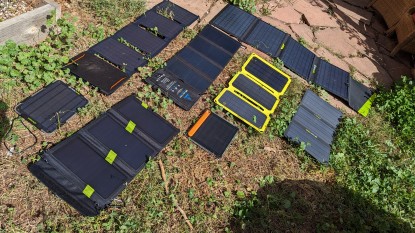Is it possible to make a solar-powered electric bike? Yes.
Is it easy and practical? That's the question we set out to answer.
Why bother making one at all? In a word: Range
Most electric vehicles that cost less than a $100,000 Tesla share the same limitation: range and slow re-charging. Of course, range is all relative. If you bike two miles a day to the store and back, most electric bikes are just fine. But if you are trying to make your electric bike replace more and more car trips, you always want more range. With that in mind, I set out some time ago to see if I could extend the range of my electric bike using a bigger camping solar panel.
We've updated this article with new product recommendations for 2017. All the components are now a little lighter, cheaper, and have longer range. But overall, the concept remains the same.
The Bike
We used the Trek Valencia+ which was replaced by the Conduit+. It has a range of 7-30 miles depending on how much pedal power you put in. We get 15 miles between charges. We can get to work and back no problem (14-mile round trip). But to go to San Francisco and back is a 30-mile round trip. To do this, we would barely make it one way, then have to recharge.
NOTE: if you are new to electric bikes, range numbers are very subjective. They depend entirely on how you ride the bike and the terrain. It's like the situation with a Toyota Prius. I can get 65+ mpg with a Prius if I hyper-mile on flat ground. On the other hand, I have a friend with a different driving style who rarely gets more than 40mpg. In general, I get around 50 in normal driving. With electric bikes, the range numbers swing even more because you choose how much and how hard you want to pedal.
The Panel
Note: Goal Zero is discontinuing the Boulder 30 and replacing it with the heavier Boulder 50 panel. At 12.5 lbs, the Boulder 50 is just too heavy for this application. Get the 30 while you can!
The Battery and Inverter
In a perfect world, the panel would plug directly into our bike's battery. We've not found a way to easily do this (send me an email if you know how we can). So we plug the panel into an inverter that then goes to the bike's charger/inverter and finally to the bike's battery. The power is going from DC to AC to DC. This probably results in a 20 percent-plus efficiency loss. Also, the battery and inverter and bike charger add another six pounds and a lot of cables to the system. Not ideal, but it works.
Did it work?
Yes. The extra Goal Zero Sherpa 100 battery alone (which starts out each day full) gave me another full charge. And in the course of a day, with my bike in the sun five-plus hours, I get another full charge. So I essentially tripled the range of my electric bike! I used to get 15 miles and now I get 45.
That said, there are some major downsides. The Trek Valencia+, which is already very back heavy, is now even worse. The whole system weighs 12 pounds. It is also expensive. Here are the costs and weight breakdowns:Bike charger: 1.5 lb.
Boulder 30 Panel: 6.6 lb. $140
Sherpa 100 Battery 3.6 lb. $300
Sherpa inverter 0.7 lb. $49
Bottom Line: Should you make a solar electric bike?
This was a fun experiment, but the cost will not be worth it to most people. Better to just bring your charger with you everywhere and find a friendly cafe that will let you plug in for a java break.
If there were a way to plug the panel directly into the bike battery, it would eliminate most of the weight and cost.
More Solar
- Check out our favorite portable solar chargers. The Sherpa 100 kit has been a past award winner.
- Our How And Why to Get Home Solar Panels Article explains why we got solar for our home and business, what are the costs and what are the benefits.





